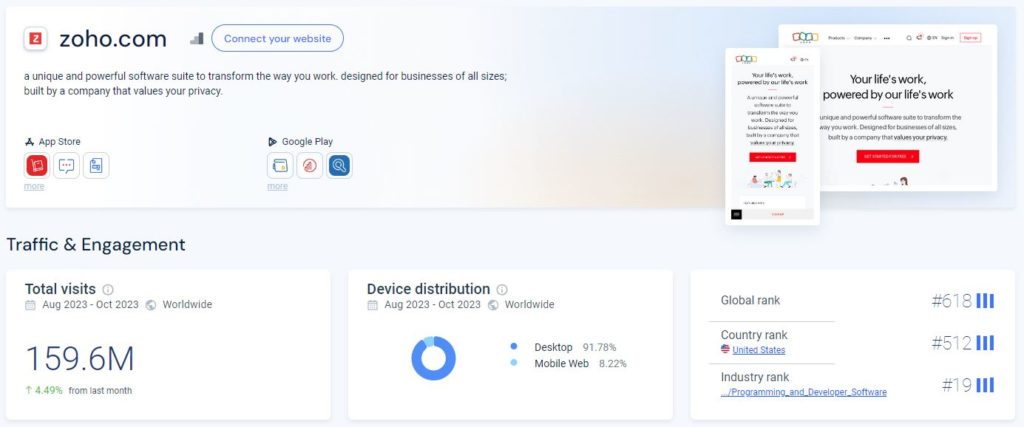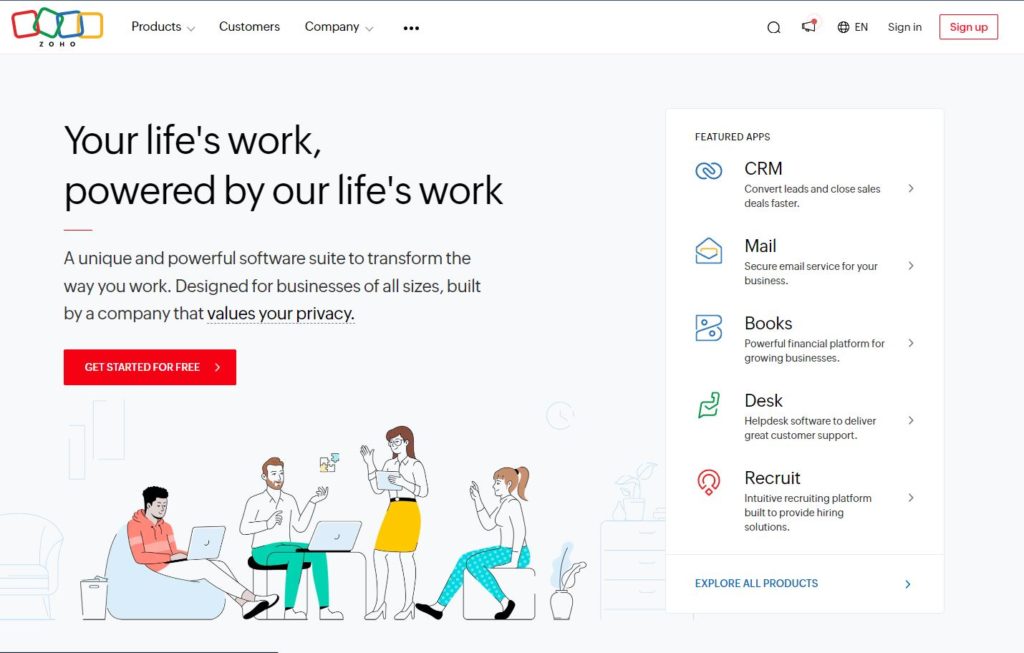
Is Zoho Good for SEO?
Zoho, launched in 1996, is much more than just a suite of online productivity tools and SaaS applications. It’s an ecosystem where businesses thrive, offering a diverse range of solutions from email hosting to collaboration tools, and CRM systems to financial management. Primarily, Zoho caters to businesses looking to streamline their operations, with a strong focus on small to medium-sized enterprises.
| Website: | zoho.com |
| Founded: | 1996 |
| Type of Platform: | Zoho offers various platforms, including analytics and document management |
| Key Features: | Online editors, cloud storage, file sharing, collaboration, and document management capabilities |
| Content Types: | Business documents, analytical data |
| Popular Content: | Business documents |
| Target Audience: | Individuals and businesses looking for data analysis and visualization tools or document management and collaboration solutions. |
| Domain Authority: | 91/100 |
Now, let’s talk SEO. Search Engine Optimization (SEO) is the art and science of enhancing a website’s visibility in search engines. Simply put, it’s about making your site more attractive to Google and other search engines, so you rank higher in search results. This matters because the higher you rank, the more likely people are to find you.

Most importantly, Zoho is SEO-friendly for a few key reasons. First, its array of tools supports the creation and management of engaging content. This is vital because engaging content is more likely to be shared, linked to, and, therefore, ranked higher by search engines. Secondly, Zoho’s tools enable efficient management of customer relationships and online presence, both of which can indirectly influence SEO performance by boosting user engagement and satisfaction.
Therefore, while Zoho itself isn’t a direct SEO tool, it offers a suite of applications that can significantly enhance a website’s SEO strategy by supporting the creation of quality content, improving user experience, and helping to manage online interactions effectively. These are all critical components of a robust SEO strategy.
Are Zoho Links Nofollow or Dofollow?
To put it bluntly, Zoho used both nofollow and dofollow links. First, let’s decode the terms ‘Nofollow’ and ‘Dofollow.’ These are HTML attributes used by webmasters to instruct search engines on how to treat links. Dofollow’ links pass on ‘link juice’ or SEO benefits from the originating site to the destination site, enhancing its ranking. Conversely, ‘Nofollow’ links tell search engines to ignore the link in terms of passing on SEO benefits.

Now, onto the burning question: Are Zoho backlinks Nofollow or Dofollow? The answer isn’t straightforward because Zoho, like many platforms, employs a mix of both, depending on the context. For instance, links in certain user-generated content areas or forums might be automatically set to ‘Nofollow’ to prevent spam. In contrast, other links within the Zoho ecosystem, especially those in trusted content or official pages, could be ‘Dofollow.’
Therefore, while Zoho does have both Nofollow and Dofollow links, the type depends on where the link is placed and the context within the Zoho ecosystem. This distinction is crucial for your SEO strategy, as it determines how much value each link contributes to your website’s search engine ranking.
How Do I Add a Backlink to Zoho?
A backlink is a link from one website to another. Think of it as a vote of confidence from one site to another; the more backlinks a website has, especially from reputable sources, the more credible it appears to search engines. Now, let’s dive into how you can add a backlink to Zoho. This process isn’t just about placing a link; it’s about ensuring it’s meaningful and contextually appropriate.
The Step-by-Step Guide to Adding a Backlink
- Create Quality Content: First and foremost, you need content worthy of linking. This could be a blog post, an article, a white paper, or any other form of content that offers value and is relevant to your audience and Zoho’s platform.
- Identify Linking Opportunities: Look for sections within Zoho where adding your link makes sense. This could be in a user forum, within a product review, or as part of a collaboration tool discussion. The key is relevance; your link should fit naturally within the content.
- Register and Participate: If you’re not already a Zoho user, you’ll need to register. Participate actively in the community. This builds credibility and makes your link more likely to be accepted and less likely to be viewed as spam.
- Add Your Link: When you’ve found the right spot and crafted the perfect piece of content, it’s time to add your link. Ensure it points directly to the relevant page on your website. Be mindful of Zoho’s guidelines for posting links to avoid being flagged as spam.
- Contribute Regularly: Don’t just drop your link and disappear. Regular participation in the Zoho community can build relationships and potentially lead to more natural backlinking opportunities.
Remember, the effectiveness of a backlink is not just in its creation but also in its relevance and the value it adds to the conversation. A well-placed backlink on Zoho can be a powerful tool in your SEO arsenal.
Best Practices for Posting on Zoho
Posting on Zoho, Dropbox, iCloud or any diverse platform with a myriad of tools and communities, requires a nuanced approach. Here are some best practices to ensure your contributions are valuable, appropriate, and well-received:
The Do’s and Don’ts of Posting on Zoho
Do’s:
- Understand the Context: Each part of Zoho has its own purpose and audience. Whether it’s a CRM forum, a productivity tool discussion, or a collaboration space, tailor your content to fit the context.
- Offer Value: Your posts should contribute meaningfully to the conversation. Share insights, answer questions, or provide helpful information that benefits other users.
- Engage Respectfully: Always interact with other users respectfully. Politeness and professionalism go a long way in establishing a positive reputation.
- Follow Zoho’s Guidelines: Familiarize yourself with Zoho’s community guidelines. Abiding by these rules is crucial for your posts to be accepted and appreciated.
- Use Clear, Concise Language: Be straightforward in your communication. Clear and concise language helps in conveying your message effectively.
Dont’s:
- Avoid Over-Promotion: Blatant self-promotion or link spamming is frowned upon. Ensure your content adds value beyond just promoting your own interests.
- Don’t Stray Off-Topic: Stay relevant to the topic of discussion. Derailing conversations with unrelated content can be disruptive.
- Refrain from Negative Behavior: Avoid confrontational or disrespectful language. Constructive criticism is okay, but negativity for its own sake is not.
- Don’t Ignore Feedback: If other users or moderators give you feedback about your posts, take it seriously. It’s an opportunity to learn and adjust.
- Don’t Overlook Quality: Poor spelling, grammar, or formatting can detract from your message. Double-check your posts for errors.
By following these do’s and don’ts, you’ll be able to navigate Zoho’s diverse landscape effectively, ensuring your contributions are not only noticed but also valued. Remember, your goal is to be a constructive part of the Zoho community, building relationships and credibility over time.
Does AmpiFire Submit to Zoho?
AmpiFire’s Role in Linking to Zoho
When it comes to AmpiFire and its relationship with Zoho, a key question emerges: Does AmpiFire submit content to Zoho? The short answer is no, AmpiFire does not facilitate content submission to Zoho, but that doesn’t mean it can’t be beneficial to your business. It’s essential to understand how AmpiFire works.

Here’s what AmpiFire does for you:
- Content Creation and Optimization: AmpiFire starts by creating and optimizing content tailored to your business and target audience. This includes articles, blog posts, and other types of content that resonate with your niche.
- Strategic Distribution: Once the content is ready, AmpiFire strategically distributes it across various online platforms, including Zoho. The aim is to leverage Zoho’s diverse ecosystem for maximum visibility and engagement.
- Performance Tracking: After submission, AmpiFire tracks the performance of your content. This includes monitoring metrics like views, engagement, and the impact on your site’s SEO.
By employing these methods, AmpiFire effectively utilizes numerous platforms as part of its broader content distribution and SEO strategy. It’s not just about submitting content; it’s about making sure that content works hard for you in the digital space, enhancing your visibility and strengthening your online presence.
Tired of not seeing the results you deserve?
Discover AmpiFire and get your press releases be seen on Google News, YouTube, SlideShare, Apple Podcasts and many more…
Click Here To Learn More
Ever wondered how to leverage Zoho for boosting your online presence? These insights might just be the edge you need. What do you think – is Zoho the untapped resource in your SEO strategy?
Frequently Asked Questions
Yes, Zoho is effective for SEO because it has a decent domain authority and offers tools that support the creation of engaging content, which is key for higher search engine rankings. It’s a solid choice compared to other platforms like WordPress, which, while more SEO-focused, doesn’t offer the same range of business tools.
Zoho uses a mix of Nofollow and Dofollow links. While Dofollow links from Zoho can be valuable for SEO, they’re not as freely available as on platforms like Medium or LinkedIn. This mixed approach helps maintain the quality and credibility of links.
AmpiFire’s standout feature is its ability to optimize and strategically distribute content to platforms like Zoho, enhancing SEO and ensuring wider visibility. This is a notch above manual submissions, as it combines content creation with SEO optimization and performance tracking.
Yes, adding backlinks to Zoho is doable but requires understanding the platform’s context and participating actively in its community. It’s simpler than on platforms like Reddit, where linking policies are more stringent.
Absolutely, following best practices like understanding the context, offering value, and engaging respectfully is crucial for effective posting on Zoho. This approach is more community-focused compared to platforms like Quora, where the emphasis is more on individual expertise.
AmpiFire stands out for its comprehensive approach, combining content creation, SEO enhancement, and performance tracking. However, tools like Hootsuite or Buffer focus more on social media management, which might be more suitable for purely social media-focused strategies.
